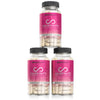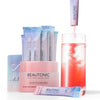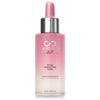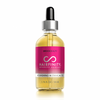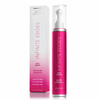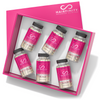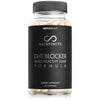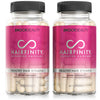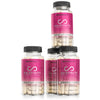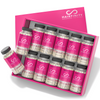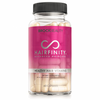
Frizzy Hair, Not Today

Frizz occurs when the cuticle layer of your hair is raised, allowing moisture to pass through and swell the strands. As a result, your hair appears dry and frizzy instead of smooth and defined. In general, curly hair tends to have more frizz than straight hair because of dehydration in the strands, which leaves it more vulnerable to frizzing. Whether your hair is curly, straight, natural, or chemically processed, we’ve all had to battle frizzy hair at one time or another. It is important to note that all frizzy hair is not created equal. There are many culprits of frizzy hair and a few different ways that your hair can appear to be frizzy. The most common types of frizz are:
- Surface frizz which is usually contained to the surface layer of the hair and is usually “activated” by humidity.
- Halo frizz occurs only at the crown of the head.
- End frizz occurs at the ends of your hair.
- Application or product frizz is caused by over usage of product and not being able to resist touching your hair (happy hands).
- Dry frizz is hair that both looks and feels dry.
There are many more types of care, climate and moisture combinations to cause a variety of ways for you to have a bad hair day because of frizzy hair. What’s important to remember is that there is a solution to frizzy hair.
The Anatomy of Our Hair
It is key to understand the anatomy of hair when trying to figure out what your hair needs. The follicle, which is embedded beneath the surface of the scalp, is the only part of the structure that is alive. Blood flow delivers vital nutrients to this base and provides the beginnings of healthy hair. That said, you now understand why we stress that you nourish your hair from the inside, in order to begin and maintain health on the outside. So in essence you can prevent frizz before it starts by incorporating Hairfinity into your diet and providing your hair with the essential building blocks for strength and health.
Beyond the follicle – we have the shaft of the hair which has a three layers, the outermost layer is called the cuticle layer. Under a microscope your hair would resemble a roof covered in overlapping shingles. These “shingle like” structures make up the cuticle and when your hair is healthy and fortified with protein the cuticle is closed and the layers are flush against one another. As your hair becomes damaged the cuticle lifts up and is now porous, allowing water (and other pollutants) to pass through and damage the hair. When the cuticle layer has lifted too much your hair is vulnerable to not only long term damage but can also become frizzy. If left unchecked the open cuticle will become susceptible to damage.

A major factor in the condition of the cuticle is the pH balance of your hair. On the pH scale most hair is acidic with a pH of between 4.5 and 5.5, while you may not be able to test your hair’s pH (kudos to you if you’ve got the tools handy) there are tell tale signs that your hair doesn’t have a great pH balance.
- Hair that is too alkaline will have cuticles that are too open. If the lifting of the cuticle goes unchecked they will not close and eventually the hair will become porous.
- Hair that is too acidic will cause cuticles to close too tightly. Cuticles that are too closed will not allow moisture in and will become dry and begin breaking off.
The good news is damage to the cuticle is not irreversible. However, if your cuticles have been damaged it will take time and a little TLC to get you hair back to its best.
Avoiding Frizzy Hair
There are so many products that are marketed as “frizz fighting”, “anti-frizz” or “frizz free” it can be hard to remember that sometimes products are the problem. Instead of investing your money in the trendy frizz fighting gimmick of the month, you should try to adding some care techniques to give your hair all you can so that it can look it’s best.
- Get a good cut – If you have curly hair this is especially important for managing frizz. A bad hair cut will lead to ends that are prone to frizz.
- Wash less – By limiting the number of times you wash your hair you are handling it less and your hair will be less likely to become frizzy.
- Deep condition – If you experience frizz you should deep condition your hair at least once a week. Pay special attention to your problem areas and smooth hair from that area of the hair down the ends.
- Add protein – You hair is made of protein, and whether you use a store bought or do a DIY protein mask, replenishing the protein supply will help lay the cuticle flat.
- Don’t towel dry – Instead of doing your mother’s towel head wrap to dry your hair after washing, use a microfiber towel or a cotton t-shirt and gently press the water out of your hair.
It’s probably a good idea to find out which styling and environmental elements causes your hair to become frizzy. Once you understand the underlying cause of your frizz you will better understand how to avoid frizzy hair.
Nutritional Frizz Fighters
We would be remiss if we omitted the very best way to have hair at it’s optimal health and help manage frizzy hair. A healthy, balanced diet can give you fabulous hair that is strong and shiny. Kudos to those of you that are filling up on Omega fatty acids, beta carotene and other essential nutrients. The truth is, most of us don’t get the full benefit that our diet can provide. You may want to try a vitamin supplement, such as Hairfinity that will fill in the gaps that your diet may miss. If you’re not familiar with the types of foods you should eat to not only get, but maintain soft healthy hair we’ve compiled the key foods that will not only make you feel good but also leave your hair looking great.
- Soybeans
- Lentils
- Eggs
- Meat
- Dark leafy veggies
- Avocados
- Whole Grains
- Salmon

There are so many foods that will contribute to your hair looking great, there has to be something on the list that you love to eat. If not, you will have to go the extra mile to make sure gentle care and treatment is given to your precious strands. You only get one head of hair! If the way that you treat it is ruining it, you need to go another route. The great thing about hair is that as long as the follicle is healthy and thriving hair growth is still possible. The bad thing is if you’ve never learned how to properly care for and maintain your hair your growth could be stunted and slow. Proper hair care is possible without breaking the bank you just be patient – the possibilities are endless.
Frizz Free Styling
If styling your hair brings out the frizz, there are many tricks that you can try in order to have cute hair that is frizz free. We mentioned several factors well within your control that will help you manage frizz. There are also several styling methods that you can either begin or completely eliminate from your routine, to get frizz free styling every time.
Do
- Heat protectant – Heat styling can be a major culprit of frizz. By using a heat protectant you will provide your hair with much needed defense against frizz and long term damage caused by heat styling.
- Better blow dryer – Ionic dryers are the best dryer to avoid frizz. They compress the cuticle and prevent your hair from frizzing up due to excess moisture.
- Curl it – If your hair is naturally curly or wavy wrapping your frizzy strands around your curling iron will help to smooth and shape your frizzy ends…..it will also give your hair a little extra body.

- Hot oil treatments – A weekly hot oil treatment will help to strengthen your cuticle thereby preventing frizz.
- Alcohol free – Skip products that contain alcohol. Alcohol causes your cuticle to swell which causes frizz to appear.
- Tame your fly-aways – Lightly mist a shine spray onto a spooled or large toothbrush and skim it over the hair to grab individual untamed hairs.
- Cool rinse – Use water at the coldest temperature that you can stand it when rinsing your conditioner. Cold water helps lock moisture in, and will help prevent frizz long before you start the process of drying and styling your hair.
Don’t
- Avoid styling products – You just need to find the styling product that is right for your hair type. It may be wise to consult a stylist about what would be best for your hair.
- Do it wrong – Many of the products that we buy don’t work for us because our application of the products is wrong. Be sure to use products as directed – you can improvise after.
- Cause dryness – Sleeping in a satin bonnet or using a satin pillow case will help retain moisture in your hair.
- Over dry – When diffusing your hair you should allow some of your hair to air dry.
- Heat damage – Overuse of flat irons, especially in very humid climates can cause damage to curls that is only repairable by cutting.
- Excessive coloring – A pop of color is a great way to update your look, but the chemicals in permanent hair color can be extremely damaging. If you choose to color your hair don’t do too many processes at once opt for highlights or single process – not both. This will help you maintain the texture of your hair.

Now that you know that frizzy hair is not a life sentence take some time and learn what your hair needs in order to always look it’s very best.
Dehydrated Hair = Frizzy Hair
Moisture, moisture, moisture – we say it all the time and will continue to stress the importance of keeping your hair well hydrated because moisture really is a great defense against damage and breakage. Hair that is moisturized will not only look great but will also feel great and be more manageable. The Capilsana® complex in Hairfinity is designed to provide your hair with the building block for healthy hair, by providing moisture directly to the follicle.
Once your hair loses moisture whether as a result of porosity or neglect the damage could take long to correct. An important factor to consider if you are experiencing “mane dehydration”, is the climate you live in. Environment plays a huge role in the health and continued growth of our hair. Everything from the water we wash with or the amount of moisture, or lack there of, in air affects our hair’s ability to retain moisture.
To better understand how to get and maintain hair that is well moisturized and sleek, allow us to introduce you to humectants. You have probably seen the word humectant in many products for skin and hair – this is because humectants promote moisture retention and if your hair is supple and well hydrated it will, of course, look great. Humidity is the most important weather factor to consider for hair care because it is the amount of moisture being held in the air.
- Low Humidity – this climate is primarily cold, dry winter air or dry desert type climates. You should limit the use of humectants in areas of low humidity because the dry air won’t have many water molecules to attract from the air. The result will be hair that is dry and tacky feeling.
- High Humidity – primarily warm or hot summer air, typically southern or tropical climates. The right amount of humidity is prime to get hair a little extra moisture using humectants. However, in places with an especially high level of humidity hair can become to moist feeling wet or sticky and can be easily tangled.
While we won’t suggest getting a degree in meteorology to understand when you should and shouldn’t use humectants, we can help you better understand the different types of humectants. By understanding which humectants are best for your hair, either naturally or in hair care products, you can understand products to either look for or avoid.
- Glycerin
- Propylene glycol
- Honey
- Agave nectar
- Sorbitol
- Sodium PCA
- Panthenol
- Hydrolyzed silk protein
- Fructose
Hairfinity hair vitamins, an innovation in hair care, is transforming the hair of women all over the world with a unique blend of vitamins, nutrients, and our exclusive Capilsana™ Complex. Hairfinity customers have reported improved manageability and an overall healthier appearance of their hair. Start YOUR journey with Hairfinity Healthy Hair Vitamins today. SHOP NOW.
















